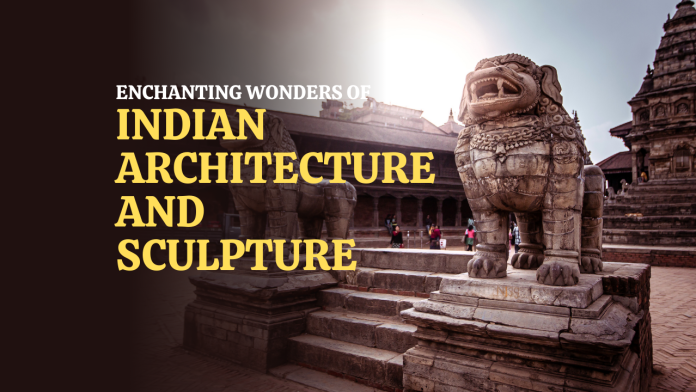Introduction to Indian Architecture and Sculpture
Indian architecture and sculpture are testaments to the nation’s rich cultural heritage and artistic prowess. These art forms have flourished over millennia, reflecting the deep-rooted traditions, diverse cultures, and evolving architectural styles of the Indian subcontinent.
Architectural Marvels of India
India boasts a stunning array of architectural wonders that span centuries and regions. The Taj Mahal, one of the Seven Wonders of the World, is an epitome of Mughal architecture. The intricately designed palaces of Jaipur, with their vibrant colors and intricate patterns, showcase the unique Rajput architecture. Ancient temples, like Khajuraho and Konark, are masterpieces of intricate stone carving and architectural precision.
The Role of Sculpture in Indian Art
Sculpture holds a prominent place in Indian art, and it complements the country’s architectural marvels. Various materials, including stone, metal, and wood, have been used to create exquisite sculptures. Techniques like carving, casting, and engraving are employed to produce detailed and awe-inspiring sculptures.
Ancient Indian Temples
Indian temples are not just religious structures; they are artistic treasures that depict tales from mythology and showcase the skills of ancient artisans. The temples of Khajuraho, renowned for their erotic sculptures, are a testament to the craftsmanship and aesthetics of ancient India.
Regional Diversity in Indian Architecture and Sculpture
India’s vast and diverse landscape is a treasure trove of architectural and sculptural diversity. Over the centuries, different regions of the country have developed their unique styles and influences, contributing to the rich tapestry of Indian art and culture.
North India:
- In North India, the influence of Mughal architecture is profound. The intricate marble work, domes, and minarets are characteristic features of this region. The Taj Mahal in Agra and the Jama Masjid in Delhi are iconic examples of Mughal architecture.
South India:
- The southern part of India is known for its distinct Dravidian architectural style. This style features towering gopurams (entrance towers), intricate stone carvings, and grand temples. Temples like the Brihadeeswarar Temple in Thanjavur and the Meenakshi Temple in Madurai are exemplary representations of Dravidian architecture.
Eastern India:
- The state of Odisha, in eastern India, is renowned for its unique temple architecture. The temples here are characterized by intricate carvings depicting various scenes from mythology and everyday life. The Konark Sun Temple, with its massive chariot-like structure, is a masterpiece of this style.
Western India:
- The western part of India, particularly in Rajasthan and Gujarat, features a blend of Rajput and Mughal architectural influences. Ornate palaces, havelis (mansions), and forts display intricate frescoes, colorful glasswork, and beautiful jharokhas (overhanging balconies).
Northeast India:
- The northeastern states offer a different architectural experience. Bamboo and thatch huts, often elevated on stilts, are typical dwellings in these regions. The use of natural materials reflects the harmony between the indigenous communities and their environment.
Central India:
- Central India showcases a fusion of architectural styles, from the ancient Buddhist rock-cut caves of Ajanta and Ellora to the grand palaces of Gwalior and Datia. This region reflects the confluence of various architectural influences over time.
Each of these regions tells a unique story through its architecture and sculpture, reflecting the historical, cultural, and geographical nuances of that area. The regional diversity adds to the overall charm and richness of Indian architecture and sculpture, making it a subject of endless fascination for art enthusiasts, historians, and tourists alike.
Influence of Religion and Culture
Religion and culture have played a significant role in shaping Indian architecture and sculpture. These art forms are imbued with symbolism and spirituality, reflecting the diverse religious beliefs and cultural practices that coexist in India.
Mughal Architecture
The Mughal dynasty left an indelible mark on Indian architecture. The fusion of Persian and Indian styles resulted in architectural marvels like the Red Fort and Humayun’s Tomb. These monuments continue to be symbols of India’s historical and cultural richness.
Modern Indian Architecture
Contemporary Indian architecture is a blend of tradition and innovation. Renowned architects like B.V. Doshi and Charles Correa have contributed to modern Indian architecture with sustainable designs and unique structures. The Lotus Temple in Delhi, with its flower-like design, is a testament to the creative prowess of modern Indian architects.
Preservation and Conservation
Preserving India’s architectural and sculptural heritage is crucial. These ancient and historical structures are susceptible to wear and tear, environmental factors, and urbanization. Organizations and government bodies are working tirelessly to conserve these cultural treasures, but challenges persist.
Conclusion
In conclusion, Indian architecture and sculpture represent the heart and soul of the country. From the grandeur of the Taj Mahal to the intricate sculptures of Khajuraho, these art forms narrate India’s history, culture, and spirituality. It is imperative that we continue to appreciate, protect, and celebrate these treasures for future generations.
FAQs
Q1: What is the significance of Indian architecture and sculpture?
Indian architecture and sculpture are significant because they showcase the rich cultural heritage, artistic prowess, and deep-rooted traditions of the Indian subcontinent.
Q2: Which are some famous examples of Indian architecture?
Prominent examples of Indian architecture include the Taj Mahal, Jaipur’s palaces, Khajuraho and Konark temples, and the Red Fort.
Q3: How have religion and culture influenced Indian architecture and sculpture?
Religion and culture have deeply influenced these art forms by imbuing them with symbolism, spirituality, and stories from mythology.
Q4: Who were the major contributors to modern Indian architecture?
Renowned architects like B.V. Doshi and Charles Correa have made significant contributions to modern Indian architecture.
Q5: Why is preservation and conservation of Indian architectural and sculptural heritage important?
Preservation and conservation are essential to protect these cultural treasures from wear and tear, environmental factors, and urbanization, ensuring they are enjoyed by future generations.



